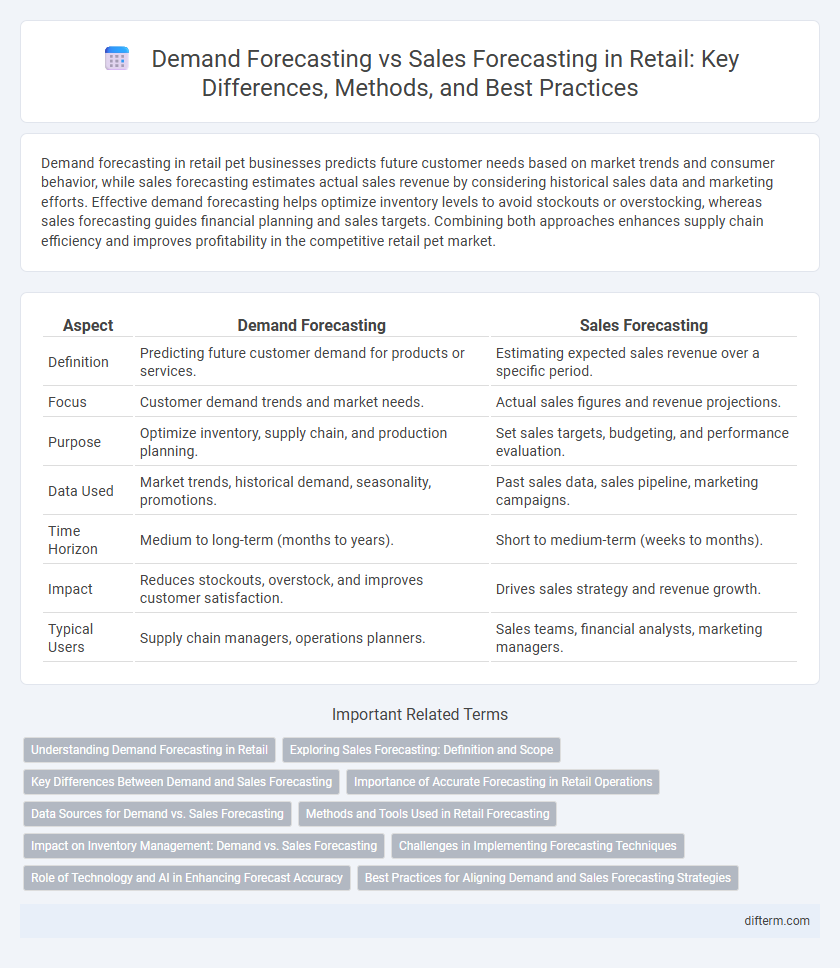Demand forecasting in retail pet businesses predicts future customer needs based on market trends and consumer behavior, while sales forecasting estimates actual sales revenue by considering historical sales data and marketing efforts. Effective demand forecasting helps optimize inventory levels to avoid stockouts or overstocking, whereas sales forecasting guides financial planning and sales targets. Combining both approaches enhances supply chain efficiency and improves profitability in the competitive retail pet market.
Table of Comparison
| Aspect | Demand Forecasting | Sales Forecasting |
|---|---|---|
| Definition | Predicting future customer demand for products or services. | Estimating expected sales revenue over a specific period. |
| Focus | Customer demand trends and market needs. | Actual sales figures and revenue projections. |
| Purpose | Optimize inventory, supply chain, and production planning. | Set sales targets, budgeting, and performance evaluation. |
| Data Used | Market trends, historical demand, seasonality, promotions. | Past sales data, sales pipeline, marketing campaigns. |
| Time Horizon | Medium to long-term (months to years). | Short to medium-term (weeks to months). |
| Impact | Reduces stockouts, overstock, and improves customer satisfaction. | Drives sales strategy and revenue growth. |
| Typical Users | Supply chain managers, operations planners. | Sales teams, financial analysts, marketing managers. |
Understanding Demand Forecasting in Retail
Demand forecasting in retail predicts future customer demand by analyzing historical sales data, market trends, and consumer behavior patterns. This process enables retailers to optimize inventory levels, reduce stockouts or overstock situations, and improve supply chain efficiency. Accurate demand forecasting supports strategic decision-making by aligning product availability with customer needs and seasonal fluctuations.
Exploring Sales Forecasting: Definition and Scope
Sales forecasting in retail involves predicting future revenue by analyzing historical sales data, market trends, and consumer behavior. This process helps retailers optimize inventory management, allocate resources efficiently, and plan marketing strategies to meet expected demand. By accurately estimating sales figures, businesses can minimize stockouts and overstock scenarios, improving profitability and customer satisfaction.
Key Differences Between Demand and Sales Forecasting
Demand forecasting predicts customer demand by analyzing market trends, seasonality, and consumer behavior, enabling retailers to optimize inventory and reduce stockouts. Sales forecasting estimates future sales based on historical sales data, marketing efforts, and sales team performance, assisting in revenue planning and target setting. The key difference lies in demand forecasting focusing on potential market need, while sales forecasting targets actual sales outcomes.
Importance of Accurate Forecasting in Retail Operations
Accurate demand forecasting in retail enables optimized inventory management, reducing stockouts and overstock situations that directly impact profitability. Sales forecasting supports strategic decision-making by predicting future revenue trends, helping allocate resources efficiently and plan marketing campaigns. Together, precise forecasting enhances customer satisfaction through product availability and drives overall operational efficiency.
Data Sources for Demand vs. Sales Forecasting
Demand forecasting in retail relies heavily on diverse data sources such as market trends, consumer behavior analytics, inventory levels, and external factors like seasonality and economic indicators. Sales forecasting, in contrast, primarily utilizes historical sales data, point-of-sale (POS) transaction records, and promotional campaign results to predict future sales performance. Integrating these distinct data sources enhances accuracy by aligning inventory management with actual consumer demand and sales patterns.
Methods and Tools Used in Retail Forecasting
Retail demand forecasting employs advanced techniques such as time series analysis, machine learning algorithms, and causal models to predict future customer demand based on historical sales data, market trends, and external factors like seasonality and promotions. Sales forecasting in retail relies on quantitative tools including regression analysis, moving averages, and point-of-sale (POS) data integration to estimate revenue performance and optimize inventory levels. Both approaches leverage software platforms like SAP IBP, Oracle Demantra, and SAS Forecasting to enhance accuracy, drive decision-making, and improve supply chain efficiency.
Impact on Inventory Management: Demand vs. Sales Forecasting
Demand forecasting directly influences inventory management by predicting future customer needs, enabling retailers to stock optimal quantities and reduce overstock or stockouts. Sales forecasting estimates actual sales based on historical data and market trends, guiding replenishment schedules and cash flow planning. Integrating both methods enhances inventory accuracy, minimizes carrying costs, and improves customer satisfaction through timely product availability.
Challenges in Implementing Forecasting Techniques
Retail demand forecasting faces challenges such as data variability caused by seasonality, promotions, and external market factors, which complicate accurate prediction models. Sales forecasting struggles with integrating real-time customer behaviors and shifting preferences, leading to discrepancies between projected and actual sales figures. Both techniques require advanced analytics and robust data integration systems to overcome issues related to data quality, model accuracy, and responsiveness to market dynamics.
Role of Technology and AI in Enhancing Forecast Accuracy
Demand forecasting leverages AI algorithms to analyze historical sales data, market trends, and consumer behavior, providing retailers with precise predictions on product demand and inventory needs. Sales forecasting, augmented by advanced technology, integrates real-time sales data and external factors such as promotions and seasonality to improve accuracy in revenue projections. Machine learning models continuously refine forecast accuracy by identifying patterns and anomalies, enabling retailers to optimize supply chain management and reduce stockouts or overstock situations.
Best Practices for Aligning Demand and Sales Forecasting Strategies
Accurate demand forecasting integrates historical sales data, market trends, and customer behavior to optimize inventory levels and reduce stockouts. Aligning demand and sales forecasting involves continuous collaboration between sales, marketing, and supply chain teams to ensure synchronized targets and real-time data sharing. Implementing advanced analytics tools like machine learning models enhances forecast precision and supports agile decision-making in retail operations.
demand forecasting vs sales forecasting Infographic

 difterm.com
difterm.com